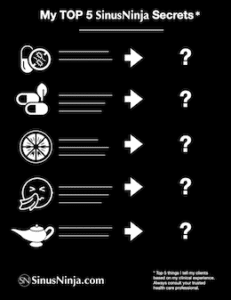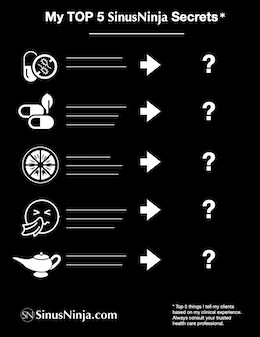You are here Home » All About Sinus Surgery
All About Sinus Surgery
Why not try a
naturopathic alternative first?
Quick Summary
This article presents a case study of a client who decided to try The Sinus Ninja Treatment™ first instead of elective sinus surgery. Greg had chronic sinus infections with facial pain, headache, and nose congestion. After an initial series of four treatments and monthly maintenance, he feels 90% better and has deferred his sinus surgery indefinitely.
Surgery, do I really need it?
When your Seattle otolaryngologist (“ENT,” or ear, nose, and throat doctor) wants to schedule you for sinus surgery, you may wonder if there are alternatives. The thought of sharp instruments inside the nose and sinuses can bring up feelings of caution and anxiety. In rare cases, surgery must be done urgently and without delay. For uncomplicated sinusitis however, surgery is typically used when alternatives and drug treatments have failed. In this article, we’ll talk in plain language about two common procedures being used by sinus surgeons in the Seattle area that seek to reduce chronic sinus pain: Endoscopic Sinus Surgery (ESS), and Balloon Sinuplasty. At the end of the article you can decide if surgery or an alternative is right for you. Let’s start with a case study.

My Top 5 Secrets!
Get your FREE PDF with my Top 5 Sinus Ninja Secrets that have helped my clients defeat sinusitis without drugs.
- Dr. Frank (Sinus Ninja)

As a Sinus Surgeon and Integrative Medicine Fellow, I know that most patients don't need something as invasive as sinus surgery. Sinus Ninja can help those patients that do not require surgical intervention.
Dr. Amy Anstead MD, FARS
Greg had chronic sinus infections with facial pain, headache, and nose congestion.
“So when are you scheduled for surgery?” The mid-50’s sales rep looked up over his eyeglass frames and said, “In six weeks. Because of my schedule, I couldn’t make it any sooner.” After hearing his story about work and family, I realized Greg was a busy guy. He simply had no time to be sick. He also believed in checking out all of his options. Rushing into drugs and surgery just wasn’t for him. So, Greg did an internet search for “naturopathic medicine for sinusitis” in Seattle and found Sinus Ninja.
He had a sinus headache and congestion that blocked the air passages in his nose.
In fact, I could tell during the interview he was breathing mostly through his mouth. “What remedies have you tried?” I asked. “Well, to get rid of the nasal congestion I tried Sudafed® for about four weeks. I didn’t like the way it made me feel. Kept me up most nights and didn’t seem to be all that effective. I heard about saline irrigation using a neti pot so I tried that for awhile. It seemed to work for about an hour then the congestion would come back.” “And then you went to your family doctor?” I continued. “Nope, my insurance plan allows me to jump right to a specialist so I thought I’d go see an otolar -” he stumbled as he said it. “An oto-laryng-ologist,” I prompted. “Yes, an otolaryngologist here in Seattle.” “Sure,” I said, “that’s a reasonable course of action. So what did you and your doctor find out?” “We did a sinus CT scan and went over the results.” “Right,” I said. “Is this the copy of the report you emailed me?” “Yep, they said the CT showed nothing too unusual. Just some ‘cloudiness’ in the sinuses. They diagnosed me with chronic sinusitis.” “So I see you are on an antibiotic,” I said. “That’s right, Amoxicillin. They also wrote me a prescription for a nasal steroid spray which I haven’t filled yet. Since it was nothing more than a chronic sinus infection, I wanted to check out other options. As long as I didn’t have any complications, it seemed like overkill to treat this so aggressively. Before I knew it, I was at the front desk scheduling my endoscopic sinus surgery.”
Greg had uncomplicated chronic sinusitis.
“Interesting story,” I said. “It seems your otolaryngologist is OK with you putting off your sinus surgery for a little while.” “Yep, we figured that since I’ve been living with sinus pain and congestion for six months, another six weeks wouldn’t make that much of a difference.”
“First, I’m glad to hear it’s nothing too serious,” I said. “Next, I want to remind us that most sinusitis is troublesome, not life-threatening. Since you made a decision to look for sinus surgery alternatives, you’ve given yourself a chance to try a less aggressive, more natural approach.” “Absolutely,” said Greg. “I believe if given the right conditions, my nose and sinuses will correct the problem. When I get a cut on my hand, my natural healing mechanism kicks in and fixes the injury. I figured there must be a way to optimize those conditions in my sinuses.”
After an initial series of four treatments and monthly maintenance, Greg feels 90% better and has deferred his sinus surgery indefinitely.
Greg completed four Sinus Ninja Treatments™ over four weeks and is scheduled for his fifth. After treatment #5 he reported a 75% reduction in nasal congestion. He reports he is able to go on airplane trips without complications. Before, his sinus symptoms and blocked ears would worsen making his flight very uncomfortable. He is happy with the results and wonders if he will ever need sinus surgery. Greg also asks if the results are permanent or will he have to maintain treatment to “hold” his current symptom-reduced state. “Time will tell if your sinus outflows are clear enough to spread out treatments,” I said. “My experience has shown that monthly treatments keep the biofilms reduced, the sinus outflows open, and the respiratory cilia (hairlike sweeping mechanisms) moving.”
The end of the story? Greg has deferred his sinus surgery indefinitely. He never filled the prescription for his nasal spray and finished his one and only course of antibiotics. He looks forward to his monthly “maintenance” treatments and complains of only minor nasal stuffiness once in a long while.
At his most recent treatment visit, he reports feeling 90% better. Since patient report is the “gold standard” measure of improvement of uncomplicated sinusitis1, Greg has opted to continue monthly maintenance treatments. He is also working with his family naturopathic doctor to identify hidden food allergies, improve his diet, optimize his wellness, and generally remove obstacles to permanent cure of his sinus problems.
Endoscopic Sinus Surgery (ESS) is considered a "less invasive" approach to sinus revision.
ESS is not a single procedure but rather a family of techniques to “revise” or correct disturbances of nose and sinus anatomy. It is the most common approach in use today for the surgical treatment of chronic sinusitis. It also describes how the surgeon enters the body. In this approach, it happens through the nostrils. Before the 1980’s, ear, nose, and throat surgeons would use “open” techniques cutting through the face and above the gumline under the upper lip. Today, these more complicated, invasive approaches are generally reserved for advanced sinus disease such as tumors.
So what actually happens during endoscopic sinus surgery? Sharp instruments are introduced through the nostrils under the guidance of video produced from a tiny camera at the end of an endoscope. An endoscope is a long tubelike device used to look inside body cavities. Watching what’s happening on a TV screen, the skilled surgeon removes what they believe to be irreversibly diseased tissue. What gets removed is guided by the surgeon’s experience and what he or she sees, or has seen on previous diagnostic endoscopy and CT scan.
While there are many names for the specific procedures and techniques, some common revisions and removals include:
- septoplasty (straightening a deviated septum)
- polyp, cyst, and fungus ball removal
- turbinoplasty (shaving down enlarged parts of the nasal passages), and removal of soft tissue and bone with intent to enhance sinus airflow.
Once inside the nose and sinuses, a surgeon may decide to do any of these revisions. The specific endoscopic procedure that removes soft tissue and bone is called ESS, or Endoscopic Sinus Surgery.
Balloon sinuplasty is a minimally invasive “alternative” to endoscopic sinus surgery.
When a coronary (heart muscle) artery is blocked and can no longer deliver a sufficient blood supply, balloon angioplasty is one surgical option. A thin “balloon” catheter is introduced into the coronary artery through a larger artery in the thigh. The balloon is then inflated at the point of blockage. LDL cholesterol, platelets, and calcium deposits are “pushed aside,” allowing improved blood flow through the diseased vessel. A wire mesh stent is often left behind to keep the artery open.
It didn’t take long to adapt and market this technology as an alternative to ESS. A company called Acclarent, Inc. located in Menlo Park, California was the first to develop and secure FDA clearance for balloon sinuplasty in 2005. One problem in cases of chronic sinusitis is narrowing of the sinus outflows. It makes sense that the same technology used for opening the arteries of the heart would work for the mucus outflows of the sinuses.
For a technology so elegant, balloon sinuplasty has yet to reveal its drawbacks. While Acclarent, Inc. is optimistic about its success2, sustained cure is unknown in the long term3. It’s well known that “pushing aside” blockages in a diseased tissue is like parting the Red Sea. Eventually, the waters recede. Even with angioplasty stents, the coronary vessels can close back up. Repeat angioplasty is often needed to reopen the vessel4. And like endoscopic sinus surgery, balloon sinuplasty doesn’t correct the original conditions that led to sinus outflow blockages in the first place. In contrast, the all-natural, non-surgical Sinus Ninja Treatment™ removes buildup of sticky biofilms, which offers a better chance of lasting nose and sinus health.
Does my sinus problem require immediate surgical consult?
Most sinus problems are troublesome, not life threatening. However, symptoms may arise that point to more advanced sinus disease. Just like any primary care doctor, naturopathic physicians are trained to detect obvious complications of sinusitis5. If one or more of the following signs are observed during your initial visit, we will advise that you leave our office and arrange a consult with an ear, nose, and throat surgeon right away:
- Increasing severity of symptoms
- Eyelid swelling, redness, and eye socket pain
- Drooping eyelid
- Vision changes
- Pupil fixed or dilated
- Symptoms spreading to both sides of face
- Development of severe headache
- Personality or mental changes
- Soft swelling over the bones of the face
- Nasal polyps occurring in one nostril, and/or occurring with nosebleed or colored discharge. These may require removal and biopsy to check for malignancy (cancer), at the otolaryngologist's discretion.
When can I get in?
- The American Academy of Otolaryngology-HNS lists the SNOT-20 as a reliable and valid assessment tool for “patient-reported measure of outcome in sino-nasal disorders such as rhinosinusitis and nasal polyposis.” Sinus Ninja uses a mini version of this on the intake form and documents improvements based on client report. entnet.org/content/rhinology-outcome-tool-snot-20
- jnjmedicaldevices.com/en-US/product-family/balloon-sinuplasty
- ncbi.nlm.nih.gov/pubmed/26848855. In a 5-year follow up, “the number of patient-reported acute exacerbations was higher among the balloon dilated patients.”
- ncbi.nlm.nih.gov/pmc/articles/PMC59599
- Naturopathic physicians are licensed by the Washington State Department of Health to diagnose and treat illness pursuant to Chapter 18.36A RCW

Dr. Amy Anstead, MD, FARS
As a Sinus Surgeon and Integrative Medicine Fellow, I know that most patients don’t need something as invasive as sinus surgery. Sinus Ninja can help those patients that do not require surgical intervention.

My TOP 5 Secrets!
Get your FREE PDF with my Top 5 Sinus Ninja Secrets that have helped my clients defeat sinusitis without drugs.
- Dr. Frank (Sinus Ninja)
First Treatment
40 minutes-
Required for NEW clients
-
Brief chat about your sinus problem
-
Please arrive 10 minutes ahead
Follow-Up Treatment
25 minutes-
For returning clients
-
Brief check-in about your sinus problem
-
Please arrive 5 minutes ahead

